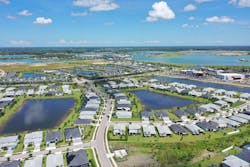This article first appeared in the September/October issue of Pro Builder
As federal dollars supporting resiliency efforts and programs are threatened, shrunk, repealed, or expired, including the annual tracking of billion-dollar weather events by a federal agency, a series of pragmatic guidelines from HUD, and tax incentives to boost the performance of new and existing homes, the onus falls on the housing industry to take the matter of resiliency into its own hands.
A jaded journalist bent on provocation might suggest that natural disasters that wipe out whole neighborhoods and more are actually good for the housing industry, an opportunity for builders and developers to cash in and keep busy with rebuilding efforts. Certainly, predatory practices are nothing new in those situations.
But that’s not me. As professionally cynical and loose-tongued as some might accuse me of being, I can’t go there.
I’d much rather see home builders take the lead in building better, above-code homes to strict, verified standards that measurably reduce the impacts of climate-driven disasters and enable people to resume their lives more quickly, perhaps even the next day.
This isn’t Pollyanna talk. It’s happening. At Babcock Ranch in southwest Florida (pictured above), at Dixon Trail in Escondido, Calif., at Veridian at County Farm in Ann Arbor, Mich., at The Atlantic Club on the shores of Long Branch, New Jersey, on roofs in Louisiana and Alabama and Maine, and even in post-Maria Puerto Rico, among others across the country.
By design and collaboration. By will and long-term commitment. By your peers.
Resiliency is a growth industry, not a passing fad
Are they losing money doing so? No. In fact, just the opposite.
Are they hitting political roadblocks? Not when policymakers see the value of reducing the cost of rebuilding after an event and the prospect of spending relief funds smarter and ideally only once.
Are they worried they’ll become obsolete by building homes and neighborhoods and communities that better weather storms and wildfires and earthquakes? Not in this lifetime. Resiliency is a growth industry, not a passing fad.
Not only are the tides rising, they’re shifting. States and municipalities can no longer deny the risk of something sweeping across their communities and leaving destruction in its wake, that federal dollars may not be there to help, that people and businesses will leave and never come back.
They want resilience. They want economic stability and homes that are durable and safe, and not just because some code says so.
They want you to step up.
Stay Connected to Pro Builder
- Subscribe to our Women at WIRC (pronounced “work”) podcast on your preferred podcast channel to hear female leaders share their insights about thriving in a male-dominated industry.
- Read more about resiliency online, including more depth about real-world solutions as well as a list of helpful resources and a glossary of terms.
About the Author

Rich Binsacca
Rich Binsacca is editorial director of Pro Builder Media and Custom Builder Online. He has reported and written about all aspects of the housing industry since 1987 and most recently was editor-in-chief of Pro Builder Media. [email protected]
